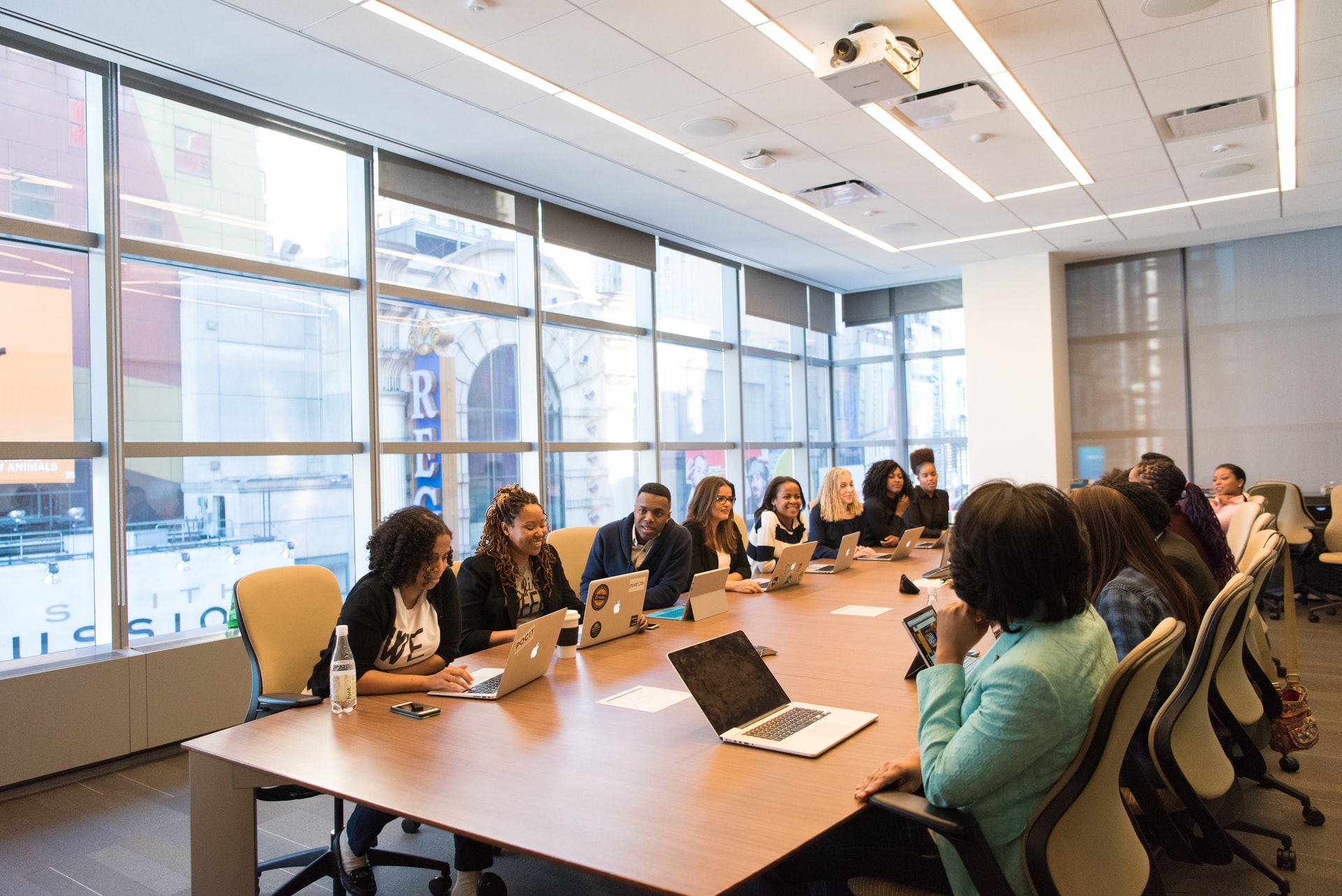How good are you at leading digital meetings?
You might write an awesome agenda, but you don’t capture decisions made.
You might be great at generating energy, but you dominate one-on-one calls.
You might always adhere to timelines, but team members are bored.
Part of the reason that running meetings is hard is that there are so many different kinds. A daily standup requires a very different skillset than running a retrospective.
And almost none of us were trained for any of them. We are thrown into the fire with a pat on the back, and we have to figure out most of it for ourselves.
Leaders in digital workplaces need proficiency and familiarity at least seven different types of meetings. You probably have a few that you are comfortable with, but others that stretch you.
Let’s look at the seven types of meetings and what each requires.
7 types of meetings in the digital world
1. The alignment meeting
Who: 3 to 10 members
How long: ~45 minutes
How often: ~Weekly
The alignment meeting is a recurring core team meeting. It’s where you sync up with your team to make sure everyone is on the same page. You make sure everyone is up to date on projects, identify any roadblocks, and quickly work through agenda items.
Digital leaders use the alignment meeting to check the pace of the team. A live meeting allows the leader to inject some energy, or pull back on the reins.
A live daily standup is one of the similar types of meetings. However, many digital workplaces opt to post updates asynchronously and just have one weekly live meeting to sort through persistent issues.
Skills required:
- Focus. This meeting should run at a quick pace and feel energizing. If you run across a heavy issue that requires more time, schedule something later to handle it.
- Triaging agenda items. Team members add agenda items on the fly. The facilitator needs to quickly identify what is best handled as an asynchronous discussion, what warrants a separate meeting, and what can be discussed immediately.
- Follow-through. The worst kind of meeting is the one that never happened because no one captured anything. Make sure tasks get added to project boards, decisions are documented, and updates are given to anyone who didn’t attend.
2. The 1:1
Who: You and a single employee
How long: 30 minutes
How often: Every one to two months
A 1:1 is a chance to break out of the whirlwind of work. During a 1:1, you aren’t talking about current projects. It’s more of a coaching call to ask questions like:
- Do they feel like they are moving forward in their career?
- Are there any team issues that have crept up that need to be addressed?
- What can you do to help them achieve their aspirations?
If you are new to 1:1s, start with some templatized questions. Of all the types of meetings, this is the one you might need the most help to get started.
Skills required:
- Coaching. It’s easy to jump into giving advice, telling someone how to solve all their problems or filling in with your own anecdotes. But coaching involves more reflective listening and allowing the other person to lead the conversation.
- Self-awareness. As the other person reflects on the team, you may learn things that don’t reflect well about you. Take this as a learning opportunity and don’t get defensive.
- Body language reading. The 1:1 is your best chance to see how someone is really doing in terms of mental health, burnout, and satisfaction in their role. They may not be ready or able to share directly, so being able to pick up on other cues is important.
3. Single issue meeting
Who: 10 people or less
How long: ~30 minutes
How often: As required
Single issue meetings are usually a byproduct from the action meeting. As the name implies, they center around just one topic.
Some examples are:
- Retrospectives of past projects
- Brainstorming sessions
- Dealing with a sensitive topic that requires live interaction
Skills required:
- Preparation. There’s a lot of opportunity for prework in single issue meetings. Send a slide deck, article, or a discussion topic that can prepare people well. You want to maximize the time for live discussion and be able to get to the heart of the matter quickly.
- Facilitation. If you are directly responsible for the project you are discussing, it is a good idea to ask someone else to facilitate. It can be hard to think deeply about the issue and also worry about including everyone and staying on topic.
4. Kickoff meeting
Who: Everyone on the project
How long: 30 minutes to an entire day, depending on the scope of the project
How often: Once
The kickoff meeting is the first meeting to start a major project. On lots of projects, many people have never worked together. Thus, this type of meeting serves to:
- Introduce people to each other
- Provide the context of the project
- Set ground rules
- Set objectives
- Discuss timelines
Of all the types of meetings, the kickoff meeting is the most important one to do live. If you have the budget to get everyone in the same room, this is the time to do it.
Skills required:
- Organization. There’s a lot to cover in a kickoff meeting. You’ve got to be prepared ahead of time and tightly organized. If your kickoff meeting is disheveled and chaotic, that doesn’t bode well for the project.
- Building connection. One of the main purposes of the kickoff meeting is to start off with a lot of relational capital. Getting through the agenda is less important than starting on a high note and everyone feeling connected and excited.
5. Governance meeting
Who: The whole team, or a smaller group
How long: Less than an hour
How often: Monthly to quarterly
This is time for the team to talk about the team. It’s a chance to review your team agreements, talk about how you work, and bring to light any elephants in the room. It’s called a governance meeting because it looks at how the team governs itself.
Skills required:
- Inclusion and adaptability. These meetings can get co-opted by the loud and highly opinionated. Don’t make decisions or edits too quickly. Give more time for slower processors.
6. Unwork meeting
Who: 10 or less
How long: 30 minutes to an hour
How often: Weekly
Unwork meetings are a chance to relax and have fun together as a team. You might find a list of games to play on Zoom with coworkers, do a round of check in questions, or catch up on life with each other.
Skills required:
- Preparation. Just because it’s unwork doesn’t mean you shouldn’t prepare. Don’t step into the time and say, “So, what does everyone want to do?”
- Delegation. This is the perfect meeting to put on rotation. Let everyone take a week to plan for something they enjoy doing to keep a good variety.
7. All-hands meeting
Who: Everyone
How long: 30 minutes to an hour
How often: Once or twice a month
The all-hands meeting is for every staff member in the company, a department, or a team of teams.
Keep in mind that all-hands meetings with more than 10 people require a sizable amount of planning. Think back to why you hired the meeting. A digital meeting is not just a place to give boring updates that could have been a post. But a live all-hands meeting is a great place to:
- Give extra context for company-wide updates
- Celebrate hitting a milestone or someone’s contribution
- Connect people who don’t normally work together
- Build energy through graphics, music, and video
Skills required:
- Event planning. The all-hands meeting is an event and requires the same amount of planning. Don’t just walk into it thinking you are going to talk your way through the whole thing.
- Imagination. How might you drive up energy across digital divides? What’s a fun way to present something that builds excitement?
Practice makes perfect for all the types of meetings
A great digital leader needs to be able to run all seven of these types of meetings. You won’t be great at all of them right away, but spend a little time trying to improve at each one as you advance.
Photo by Jason Goodman on Unsplash
How good are you at leading digital meetings?
You might write an awesome agenda, but you don’t capture decisions made.
You might be great at generating energy, but you dominate one-on-one calls.
You might always adhere to timelines, but team members are bored.
Part of the reason that running meetings is hard is that there are so many different kinds. A daily standup requires a very different skillset than running a retrospective.
And almost none of us were trained for any of them. We are thrown into the fire with a pat on the back, and we have to figure out most of it for ourselves.
Leaders in digital workplaces need proficiency and familiarity at least seven different types of meetings. You probably have a few that you are comfortable with, but others that stretch you.
Let’s look at the seven types of meetings and what each requires.
7 types of meetings in the digital world
1. The alignment meeting
Who: 3 to 10 members
How long: ~45 minutes
How often: ~Weekly
The alignment meeting is a recurring core team meeting. It’s where you sync up with your team to make sure everyone is on the same page. You make sure everyone is up to date on projects, identify any roadblocks, and quickly work through agenda items.
Digital leaders use the alignment meeting to check the pace of the team. A live meeting allows the leader to inject some energy, or pull back on the reins.
A live daily standup is one of the similar types of meetings. However, many digital workplaces opt to post updates asynchronously and just have one weekly live meeting to sort through persistent issues.
Skills required:
- Focus. This meeting should run at a quick pace and feel energizing. If you run across a heavy issue that requires more time, schedule something later to handle it.
- Triaging agenda items. Team members add agenda items on the fly. The facilitator needs to quickly identify what is best handled as an asynchronous discussion, what warrants a separate meeting, and what can be discussed immediately.
- Follow-through. The worst kind of meeting is the one that never happened because no one captured anything. Make sure tasks get added to project boards, decisions are documented, and updates are given to anyone who didn’t attend.
2. The 1:1
Who: You and a single employee
How long: 30 minutes
How often: Every one to two months
A 1:1 is a chance to break out of the whirlwind of work. During a 1:1, you aren’t talking about current projects. It’s more of a coaching call to ask questions like:
- Do they feel like they are moving forward in their career?
- Are there any team issues that have crept up that need to be addressed?
- What can you do to help them achieve their aspirations?
If you are new to 1:1s, start with some templatized questions. Of all the types of meetings, this is the one you might need the most help to get started.
Skills required:
- Coaching. It’s easy to jump into giving advice, telling someone how to solve all their problems or filling in with your own anecdotes. But coaching involves more reflective listening and allowing the other person to lead the conversation.
- Self-awareness. As the other person reflects on the team, you may learn things that don’t reflect well about you. Take this as a learning opportunity and don’t get defensive.
- Body language reading. The 1:1 is your best chance to see how someone is really doing in terms of mental health, burnout, and satisfaction in their role. They may not be ready or able to share directly, so being able to pick up on other cues is important.
3. Single issue meeting
Who: 10 people or less
How long: ~30 minutes
How often: As required
Single issue meetings are usually a byproduct from the action meeting. As the name implies, they center around just one topic.
Some examples are:
- Retrospectives of past projects
- Brainstorming sessions
- Dealing with a sensitive topic that requires live interaction
Skills required:
- Preparation. There’s a lot of opportunity for prework in single issue meetings. Send a slide deck, article, or a discussion topic that can prepare people well. You want to maximize the time for live discussion and be able to get to the heart of the matter quickly.
- Facilitation. If you are directly responsible for the project you are discussing, it is a good idea to ask someone else to facilitate. It can be hard to think deeply about the issue and also worry about including everyone and staying on topic.
4. Kickoff meeting
Who: Everyone on the project
How long: 30 minutes to an entire day, depending on the scope of the project
How often: Once
The kickoff meeting is the first meeting to start a major project. On lots of projects, many people have never worked together. Thus, this type of meeting serves to:
- Introduce people to each other
- Provide the context of the project
- Set ground rules
- Set objectives
- Discuss timelines
Of all the types of meetings, the kickoff meeting is the most important one to do live. If you have the budget to get everyone in the same room, this is the time to do it.
Skills required:
- Organization. There’s a lot to cover in a kickoff meeting. You’ve got to be prepared ahead of time and tightly organized. If your kickoff meeting is disheveled and chaotic, that doesn’t bode well for the project.
- Building connection. One of the main purposes of the kickoff meeting is to start off with a lot of relational capital. Getting through the agenda is less important than starting on a high note and everyone feeling connected and excited.
5. Governance meeting
Who: The whole team, or a smaller group
How long: Less than an hour
How often: Monthly to quarterly
This is time for the team to talk about the team. It’s a chance to review your team agreements, talk about how you work, and bring to light any elephants in the room. It’s called a governance meeting because it looks at how the team governs itself.
Skills required:
- Inclusion and adaptability. These meetings can get co-opted by the loud and highly opinionated. Don’t make decisions or edits too quickly. Give more time for slower processors.
6. Unwork meeting
Who: 10 or less
How long: 30 minutes to an hour
How often: Weekly
Unwork meetings are a chance to relax and have fun together as a team. You might find a list of games to play on Zoom with coworkers, do a round of check in questions, or catch up on life with each other.
Skills required:
- Preparation. Just because it’s unwork doesn’t mean you shouldn’t prepare. Don’t step into the time and say, “So, what does everyone want to do?”
- Delegation. This is the perfect meeting to put on rotation. Let everyone take a week to plan for something they enjoy doing to keep a good variety.
7. All-hands meeting
Who: Everyone
How long: 30 minutes to an hour
How often: Once or twice a month
The all-hands meeting is for every staff member in the company, a department, or a team of teams.
Keep in mind that all-hands meetings with more than 10 people require a sizable amount of planning. Think back to why you hired the meeting. A digital meeting is not just a place to give boring updates that could have been a post. But a live all-hands meeting is a great place to:
- Give extra context for company-wide updates
- Celebrate hitting a milestone or someone’s contribution
- Connect people who don’t normally work together
- Build energy through graphics, music, and video
Skills required:
- Event planning. The all-hands meeting is an event and requires the same amount of planning. Don’t just walk into it thinking you are going to talk your way through the whole thing.
- Imagination. How might you drive up energy across digital divides? What’s a fun way to present something that builds excitement?
Practice makes perfect for all the types of meetings
A great digital leader needs to be able to run all seven of these types of meetings. You won’t be great at all of them right away, but spend a little time trying to improve at each one as you advance.
Photo by Jason Goodman on Unsplash
)
)
)







